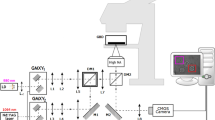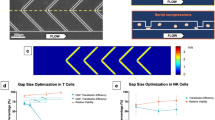Abstract
In contrast to adherent cells, cells growing in suspension and particularly hematopoietic cells, are notoriously difficult to transfect in vitro using nonviral approaches. In the present study, the effect of cell adhesion on gene transfer efficacy was investigated by allowing hematopoietic cells to bind to an adherent cell monolayer (ACM) before being subjected to cationic liposome-mediated DNA transfer. Human CD34 and T CD4 cell lines were cultivated on an ACM constituted of murine fibroblast NIH3T3 cells and transfected with a plasmid carrying the β-galactosidase gene. X-gal staining showed that up to 27% of the cells expressed the transgene. In contrast, less than 0.1% of these cells were positively transfected in suspension. This adhesion-assisted lipofection (AAL) procedure was also successfully tested on blood lymphocytes, since it resulted in up to 30% of transfected human primary T lymphocytes. Flow cytometry analysis performed on T lymphocyte subsets revealed that 8 and 9%, respectively, of CD4 and CD8 cells could be transfected with a plasmid carrying the green fluorescent protein gene. Other adherent cells, such as MS5 murine stromal cells or HeLa epithelial cells, were also a compatible matrix for AAL. Moreover, the pCMVβ plasmid was present in similar amounts in the nuclei of TF1 cells transfected in suspension or with the AAL procedure. These data raise the possibility that cell matrix/ hematopoietic cell interactions might govern expression of the transgene in hematopoietic cells growing usually in suspension, but not endocytosis of liposome/DNA particles and plasmid migration to the cell nucleus.
This is a preview of subscription content, access via your institution
Access options
Subscribe to this journal
Receive 12 print issues and online access
$259.00 per year
only $21.58 per issue
Buy this article
- Purchase on Springer Link
- Instant access to full article PDF
Prices may be subject to local taxes which are calculated during checkout







Similar content being viewed by others
References
Felgner PL et al. Lipofection: a highly efficient, lipid-mediated DNA transfection procedure Proc Natl Acad Sci USA 1987 84: 7413–7417
Felgner PL, Ringold GM . Cationic liposome-mediated transfection Nature 1989 337: 387–388
Felgner JH et al. Enhanced gene delivery and mechanism studies with a novel series of cationic lipid formulation J Biol Chem 1994 269: 2550–2561
Stewart MJ et al. Gene transfer in vivo with DNA–liposome complexes: safety and acute toxicity in mice Hum Gene Ther 1992 3: 267–275
Hawley-Nelson P et al. Lipofectamine reagent: a new, higher efficiency polycationic liposome transfection reagent Focus 1993 15: 73–79
Labat-Moleur F et al. An electron microscopy study into the mechanism of gene transfer with lipopolyamines Gene Therapy 1996 3: 1010–1017
Harrison GS et al. Optimization of gene transfer using cationic lipids in cell lines and primary human CD34+ and CD34+ hematopoietic cells Bio Techniques 1995 19: 816–823
Aksentijevich I et al. In vitro and in vivo liposome-mediated gene transfer leads to human MDR1 expression in mouse bone marrow progenitor cells Hum Gene Ther 1996 7: 1111–1122
Behr JP . Gene transfer with synthetic cationic amphiphiles: prospects for gene therapy Bioconj Chem 1994 5: 382–389
Zhou XH, Huang L . DNA transfection mediated by cationic liposomes containing lipopolylysine characterization and mechanism of action Biochim Biophys Acta 1994 1189: 195–203
Friend DS, Papahadjopoulos D, Debs RJ . Endocytosis and intracellular processing accompanying transfection mediated by cationic liposomes Biochim Biophys Acta 1996 1278: 41–50
Behr JP, Demeneix B, Loeffler JP, Perez-Mutul J . Efficient gene transfer into mammalian primary endocrine cells with lipopolyamine-coated DNA Proc Natl Acad Sci USA 1989 86: 6982–6986
Barthel F, Remy JS, Loeffler JP, Behr JP . Gene transfer optimization with lipospermine-coated DNA DNA Cell Biol 1993 6: 553–560
Zabner J et al. Cellular and molecular barrier to gene transfer by a cationic lipid J Biol Chem 1995 270: 18997–19007
Farhood H, Serbina N, Huang L . The role of phosphatidylethanolamine in cationic liposome mediated gene transfer Biochim Biophys Acta 1995 1235: 289–295
Fasbender A et al. Effect of co-lipids in enhancing cationic lipid-mediated gene transfer in vitro and in vivo Gene Therapy 1997 4: 716–725
Moritz T, Patel VP, Williams DA . Bone marrow extracellular matrix molecules improve gene transfer into human hematopoietic cells via retroviral vectors J Clin Invest 1994 93: 1451–1457
Xu LC et al. Growth factors and stromal support generate very efficient retroviral transduction of peripheral blood CD34+ cells from Gaucher patients Blood 1995 86: 141–146
Moore KA et al. Stromal support enhances cell-free retroviral vector transduction of human bone marrow long-term culture-initiating cells Blood 1992 79: 1393–1399
Bordignon C et al. Gene therapy in peripheral blood lymphocytes and bone marrow for ADA-immunodeficient patients Science 1995 270: 470–475
Hanenberg H et al. colocalization of retrovirus and target cells on specific fibronectin fragments increases genetic transduction of mammalian cells Nature Med 1996 2: 876–882
Moritz T et al. Fibronectin improves transduction of reconstituting hematopoietic stem cells by retroviral vectors: evidence of direct viral binding to chymotryptic carboxy-terminal fragments Blood 1996 88: 855–862
Logan JL et al. Cationic lipids for reporter gene and CFTR transfer to rat pulmonary epithelium Gene Therapy 1995 2: 38–49
Dowty ME, Williams PW, Zhang G, Wolff JA . Plasmid DNA entry into post-mitotic nuclei of primary rat myotubes Proc Natl Acad Sci USA 1995 92: 4572–4576
Bebok Z et al. Efficiency of plasmid delivery and expression after lipid-mediated gene transfer to human cells in vitro J Pharm Exp Ther 1996 279: 1462–1469
Kobari L et al. Hematopoietic promoting activity of the murine stromal cell line MS-5 is not related to the expression of the major hematopoietic cytokines J Cell Physiol 1995 163: 295–304
Xu LC et al. Long-term in vivo expression of the human glucocerebrosidase gene in nonhuman primate after CD34+ hematopoietic cell transduction with cell-free retroviral vector preparations Proc Natl Acad Sci USA 1995 92: 4372–4376
Goncalves F et al. Stromal cells maintain the radioprotective capacity of CFU-S during retroviral infection Gene Therapy 1996 3: 761–768
Gordon MY . Stromal cells negatively regulate primitive haemopoietic progenitor cell activation via phosphatidyl inisitol-anchored cell adhesion/signaling mechanism Br J Haematol 1997 96: 647–653
Koeffler HP et al. An undifferentiated variant derived from the human acute myelogenous leukemia cell line (KG-1) Blood 1980 56: 265–273
Kitamura T et al. Establishment and characterization of a unique human cell line that proliferates dependently on GM-CSF, IL-3 or erythropoietin J Cell Physiol 1989 140: 323–334
Bagnis C et al. Retroviral transfer of the nlsLacZ gene into human CD34+ cell populations and into TF-1 cells: future prospects in gene therapy Hum Gene Ther 1994 5: 1325–1333
Itoh K et al. Reproducible establishment of haemopoietic supportive stromal cell lines from murine bone marrow Exp Hematol 1989 17: 143–153
Issaad C et al. A murine stromal cell line allows the proliferation of very primitive human CD34+, CD38− progenitor cells in long-term cultures and semisolid assays Blood 1993 81: 2916–2924
MacGregor GR, Mogg AE, Burke JF, Caskey CT . Histochemical staining of clonal mammalian cell lines expressing E. coli beta galactosidase indicates heterogeneous expression of the bacterial gene Somat Cell Mol Genet 1987 13: 253–265
Lin WC, Culp LA . Selectable plasmid vectors with alternative and ultrasensitive histochemical marker genes Bio Techniques 1991 11: 344–351
Bagnis C et al. Leukemogenicity of v-myb transformed monoblasts cells can be modulated by normal bone marrow environment Oncogene 1993 8: 737–743
Ozato K, Mayer NM, Sachs DH . Monoclonal antibodies to mouse major histocompatibility complex antigens Transplantation 1982 34: 113–120
Author information
Authors and Affiliations
Rights and permissions
About this article
Cite this article
Keller, H., Yunxu, C., Marit, G. et al. Transgene expression, but not gene delivery, is improved by adhesion-assisted lipofection of hematopoietic cells. Gene Ther 6, 931–938 (1999). https://doi.org/10.1038/sj.gt.3300896
Received:
Accepted:
Published:
Issue Date:
DOI: https://doi.org/10.1038/sj.gt.3300896



